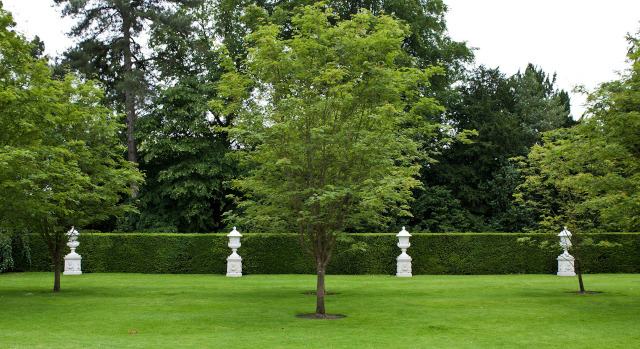Living Fences: Types, Benefits & How To Build One

Table of Contents
Types of Living Fences
Choosing the right plants for your living fence is crucial for its success and aesthetic appeal. Consider factors like your climate, desired height, and the level of maintenance you're willing to undertake.
Fast-Growing Options
For those seeking quick results, several fast-growing shrubs are ideal for establishing a living fence rapidly.
- Leyland Cypress: Known for its rapid growth and dense foliage, providing excellent privacy quickly. However, it can become quite large and requires regular pruning.
- Privet: A versatile option offering dense growth and tolerance to various soil conditions. It's relatively low-maintenance but might require occasional pruning to maintain shape.
- Bamboo: A striking choice offering incredibly fast growth and a unique aesthetic. However, some bamboo varieties are invasive, so careful selection is essential. Consider clumping bamboo varieties to prevent uncontrolled spreading.
Flowering Varieties
Add bursts of color and attract pollinators to your garden with flowering hedges.
- Spirea: Known for its profuse blooms in various colors, offering seasonal interest and attracting butterflies and bees. Requires moderate pruning to maintain shape.
- Potentilla: A low-maintenance shrub with vibrant flowers throughout the summer. Attracts pollinators and offers a beautiful, less formal look.
- Forsythia: A popular choice for early spring color, offering a bright yellow display before other plants leaf out. Requires minimal pruning.
Evergreen vs. Deciduous
The choice between evergreen and deciduous plants depends on your priorities.
- Evergreen: Provides year-round privacy and screening, maintaining a consistent visual barrier. Examples include Holly and Yew.
- Deciduous: Offers seasonal color changes, providing visual interest throughout the year. They offer less privacy during the winter months when leaves drop. Examples include Hawthorn and Beech. Consider mixing evergreen and deciduous plants for year-round interest.
Thorny Plants for Security
Enhance security naturally with thorny plants that act as a deterrent to intruders.
- Hawthorn: Dense, thorny growth creates a formidable barrier. Requires regular pruning.
- Blackthorn: A very thorny option, providing excellent security but demanding regular maintenance due to its vigorous growth.
- Osage Orange: Known for its incredibly thorny branches and extremely dense growth, this makes an effective and almost impenetrable living fence, although it is not suitable for all climates.
Benefits of Living Fences
Beyond their aesthetic appeal, living fences offer a multitude of benefits.
Environmental Advantages
Living fences are environmentally friendly and contribute to a healthier planet.
- Reduced Carbon Footprint: Plants absorb carbon dioxide, helping reduce your carbon footprint.
- Habitat Creation: Provide shelter and food sources for birds, insects, and other wildlife, fostering biodiversity.
- Erosion Control: Help stabilize soil and prevent erosion, particularly on slopes.
- Improved Air Quality: Plants filter pollutants from the air, improving air quality in your surroundings.
- Natural Pest Control: Certain plants can deter pests naturally, reducing the need for harmful pesticides.
Aesthetic Appeal
Living fences enhance the beauty and value of your property.
- Increased Property Value: Well-maintained living fences increase curb appeal and property value.
- Improved Curb Appeal: Add a touch of natural elegance and sophistication to your landscape.
- Variety of Colors and Textures: Choose from a wide range of plants to create a visually stunning and unique fence.
Cost-Effectiveness
While the initial investment may be comparable to traditional fencing, living fences offer long-term cost savings.
- Lower Initial Investment (potentially): Depending on plant choices, the initial cost can be lower than some traditional fencing materials.
- Reduced Maintenance Costs (in the long run): Compared to materials like wood or vinyl which may require frequent repair or replacement, living fences require less maintenance in the long run.
- Long-Term Savings: The longevity of a well-maintained living fence results in long-term cost savings.
Privacy & Sound Reduction
Living fences provide a natural screen for privacy and can reduce noise pollution.
- Density of Planting: Denser planting provides better privacy and sound buffering.
- Plant Height: Taller plants offer greater privacy and noise reduction.
- Effectiveness Varies: Effectiveness depends on the density of planting, plant height, and the type of sound or visual intrusion.
How to Build a Living Fence
Building a living fence is a rewarding project that adds beauty and value to your property.
Planning & Design
Careful planning is essential for a successful living fence.
- Site Assessment: Evaluate your site's sunlight, soil type, and drainage.
- Choosing the Right Plants: Select plants suitable for your climate and desired aesthetic.
- Spacing Requirements: Ensure adequate spacing between plants for growth.
- Sunlight & Soil Conditions: Choose plants that thrive in your specific sun and soil conditions.
- Local Regulations: Check local regulations regarding fence height and plant choices.
Planting & Maintenance
Proper planting and ongoing care are vital for a thriving living fence.
- Preparing the Ground: Clear the area, amend the soil if necessary, and prepare planting holes.
- Planting Techniques: Plant according to recommended spacing and depth.
- Watering: Water regularly, especially during dry periods.
- Fertilizing: Feed plants annually to promote healthy growth.
- Pruning: Prune regularly to maintain shape and size.
- Pest and Disease Control: Address any pest or disease issues promptly.
Tools & Materials
Gather the necessary tools and materials before you begin.
- Shovel: For digging planting holes.
- Post Hole Digger (optional): For larger plants or posts.
- Plants: Choose your preferred species and ensure they are healthy.
- Stakes (optional): For supporting young plants.
- Mulch: Helps retain moisture and suppress weeds.
- Gardening Gloves: Protect your hands.
- Watering Can: For watering newly planted shrubs.
- Pruning Shears: For maintaining the shape of your living fence.
Conclusion
Living fences offer a compelling alternative to traditional fencing, combining natural beauty with numerous environmental and economic benefits. From fast-growing options for quick privacy to flowering varieties that attract pollinators, the choices are diverse. By understanding the different types of living fences, their advantages, and the simple steps to build one, you can transform your property into a vibrant and sustainable haven. Start planning your dream living fence today! Discover the perfect plants for your needs at your local nursery, or consult online gardening resources for further guidance. Embrace the natural beauty and long-term benefits of a living fence—a truly sustainable and aesthetically pleasing way to enhance your property.

Featured Posts
-
 Trumps Criticism Of Putin Dismissed By Russia As Emotional
May 29, 2025
Trumps Criticism Of Putin Dismissed By Russia As Emotional
May 29, 2025 -
 Brshlwnt Wtah Tfasyl Alqrar Almfajy
May 29, 2025
Brshlwnt Wtah Tfasyl Alqrar Almfajy
May 29, 2025 -
 Six Year Old Trafficking Case Mothers Guilty Verdict And Organ Trade Implications
May 29, 2025
Six Year Old Trafficking Case Mothers Guilty Verdict And Organ Trade Implications
May 29, 2025 -
 Covid 19 Vaccines A Potential Shield Against Long Covid
May 29, 2025
Covid 19 Vaccines A Potential Shield Against Long Covid
May 29, 2025 -
 Male Escorts Apology To Cassie Following Diddy Sex Party Allegations
May 29, 2025
Male Escorts Apology To Cassie Following Diddy Sex Party Allegations
May 29, 2025
Latest Posts
-
 Where Is Measles Spreading In The United States
May 30, 2025
Where Is Measles Spreading In The United States
May 30, 2025 -
 Measles Cases In The U S Latest Updates And Locations
May 30, 2025
Measles Cases In The U S Latest Updates And Locations
May 30, 2025 -
 U S Measles Outbreak Tracking The Spread Of Cases
May 30, 2025
U S Measles Outbreak Tracking The Spread Of Cases
May 30, 2025 -
 Tomas Koloc A Jeho Svet Oslavy Jardy A Vlady
May 30, 2025
Tomas Koloc A Jeho Svet Oslavy Jardy A Vlady
May 30, 2025 -
 Kyonigsbergskaya Operatsiya Rol Blagoveschenskoy Tserkvi I Figura Karpova
May 30, 2025
Kyonigsbergskaya Operatsiya Rol Blagoveschenskoy Tserkvi I Figura Karpova
May 30, 2025
